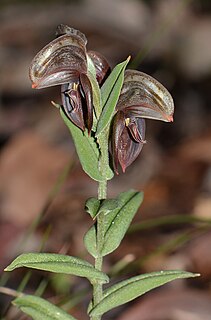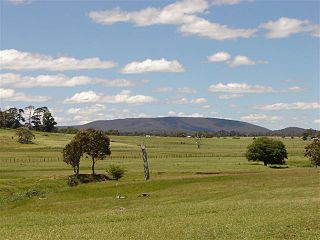
Pterostylis coccina, commonly known as the scarlet greenhood, is a species of orchid endemic to eastern Australia. As with similar greenhoods, the flowering plants differ from those which are not flowering. The non-flowering plants have a rosette of leaves flat on the ground but the flowering plants have a single flower with leaves on the flowering spike. In this species, the rosette leaves are relatively large and dark green, and the flowers are white, and bluish-green or red. It grows in New South Wales and north-eastern Victoria.

Pterostylis grandiflora, commonly known as the cobra greenhood or superb greenhood, is a species of orchid endemic to south-eastern Australia. As with similar orchids, the flowering plants differ from those which are not flowering. The non-flowering plants have a rosette of leaves but the flowering plants lack a rosette and have a single flower with leaves on the flowering spike. This greenhood has a green and white, striped flower with deep red-brown markings especially on its "galea", and a sharply pointed dorsal sepal.

Pterostylis abrupta, commonly known as the tablelands greenhood, is a species of orchid endemic to New South Wales. It is distinguished from similar greenhood orchids by its thick, flat, platform-like sinus and blunt labellum which is only just visible above the sinus.

Pterostylis aestiva, commonly known as the long-tongued summer greenhood, is a species of orchid endemic to south-eastern Australia. As with similar greenhoods, the flowering plants differ from those which are not flowering. The non-flowering plants have a rosette of leaves flat on the ground but the flowering plants have a single flower with leaves on the flowering spike.

Pterostylis atrans, commonly known as the dark-tip greenhood or blunt-tongue greenhood, is a species of orchid endemic to south-eastern Australia. As with similar greenhoods, plants in flower differ from those that are not flowering. The non-flowering plants have a rosette of leaves flat on the ground, but the plants in flower have a single flower with leaves on the flowering spike. In this species, the flower is green and reddish brown with a protruding sinus and small club-like tips on the ends of the lateral sepals.

Pterostylis ventricosa is a recently described and critically endangered species of orchid endemic to a small area of New South Wales. As with similar orchids, the flowering plants differ from those which are not flowering. The non-flowering plants have a rosette of leaves but the flowering plants lack a rosette at the base but have up to six tiny green, white and brown flowers.

Pterostylis multiflora, commonly known as the tall tiny greenhood, is a species of orchid endemic to south-eastern Australia. As with similar orchids, plants in flower differ from those that are not. Those not in flower have a rosette of leaves lying flat on the ground. Plants in flower lack a rosette but have up to twenty tiny green, white, and brown flowers in summer. The flowering stem has up to six stem leaves.

Pterostylis rubescens, commonly known as the blushing tiny greenhood, is a species of orchid endemic to south-eastern Australia. As with similar orchids, the flowering plants differ from those which are not flowering. The non-flowering plants have a rosette of leaves but the flowering plants lack a rosette at the base and have up to eighteen tiny green, white and brownish flowers.
Pterostylis anatona, commonly known as the Eungella greenhood, is a species of orchid endemic to Queensland. It has a rosette of wrinkled leaves at the base of the plant and a single light green and white flower, reddish towards its tip. It grows in higher areas between Eungella and the Blackdown Tableland National Park.
Pterostylis aquilonia, commonly known as the northern cobra greenhood, is a species of orchid endemic to Queensland. As with similar orchids, the flowering plants differ from those which are not flowering. The non-flowering plants have a rosette of leaves but the flowering plants lack a rosette and have a single flower with leaves on the flowering spike. This greenhood has a relatively large green, white and reddish-brown self-pollinating flower.

Pterostylis concava, commonly known as the pouched greenhood or cupped banded greenhood, is a plant in the orchid family Orchidaceae and is endemic to the south-west of Western Australia. The plants either have a rosette of leaves in the years when not flowering or stem leaves on a flowering spike. When flowering, it has up to ten or more flowers which are dark reddish-brown, sometimes green and white with deeply cupped lateral sepals. It is an uncommon orchid, mostly found between Bindoon and Mount Barker.
Pterostylis crassichila, commonly known as the plump northern greenhood, is a species of orchid endemic to Queensland. It has a rosette of leaves at the base of the plant and a single white flower with green lines, reddish towards its tip. It grows in higher areas of north Queensland.
Pterostylis erythroconcha, commonly known as the red shell orchid, is a species of orchid endemic to South Australia. As with similar orchids, the flowering plants differ from those which are not flowering. The non-flowering plants have a rosette of leaves but the flowering plants have a single flower with leaves on the flowering spike. This greenhood has a white and green flower with reddish brown markings and a long, fleshy, curved labellum.

Pterostylis major is a plant in the orchid family Orchidaceae and is endemic to New South Wales where it grows on the Northern Tablelands. As with similar greenhoods, the flowering plants differ from those which are not flowering. The non-flowering plants have a rosette of leaves on a short stalk but the flowering plants lack a rosette and have up to eleven well-spaced, bright green flowers with darker stripes, on a flowering stem with stem leaves.
Pterostylis nigricans, commonly known as the dark greenhood, is a species of orchid endemic to eastern Australia. As with similar orchids, the flowering plants differ from those which are not flowering. The non-flowering plants have a rosette of leaves but the flowering plants lack a rosette at the base but have up to six tiny green, white and brown flowers which have a rough texture.

Pterostylis torquata, commonly known as the collared greenhood, is a species of orchid endemic to New South Wales. As with similar greenhoods, the flowering plants differ from those which are not flowering. The non-flowering plants have a rosette of leaves flat on the ground but the flowering plants have a single flower with leaves on the flowering stem. This greenhood has a white flower with dark green and dark brown markings, although in some areas, the flowers lack the brown markings. The sinus between the lateral sepals is platform-like.
Pterostylis uliginosa, commonly known as the marsh greenhood, is a species of orchid endemic to south-eastern Australia. As with similar orchids, the flowering plants differ from those which are not flowering. The non-flowering plants have a rosette of leaves but the flowering plants lack a rosette at the base but have up to three rosettes on lateral growths and up to seven small green and white flowers. This species only grows in wet places, usually where there is free water. There are usually only two or three flowers per plant, and only one or two are open at a time.
Pterostylis vernalis, commonly known as the spring tiny greenhood, is a species of orchid endemic to New South Wales. As with similar orchids, the flowering plants differ from those that are not currently flowering. Non-flowering plants have a rosette of leaves at the base. Flowering plants lack that rosette, but have one or two rosettes on lateral growths. The flowers are green, brown and white. This greenhood is only known from a small area near Nowra.
Pterostylis divaricata is a species of orchid endemic to northern New South Wales. It grows in colonies of genetically identical plants. As with similar orchids, plants in flower differ from those that are not. Those not in flower have a rosette of leaves that lie flat on the ground. Plants in flower lack a rosette at the base but have up to ten translucent white flowers with green and brown stripes. This greenhood is similar to P. striata but has larger flowers and a longer tip on the dorsal sepal.
Pterostylis rubiginosa is a species of orchid endemic to northeastern New South Wales. Flowering and non-flowering plants have a rosette of leaves that is withered by the time flowering occurs. Flowering plants have up to seven white flowers with rusty brown stripes, on a wiry flowering stem.




















